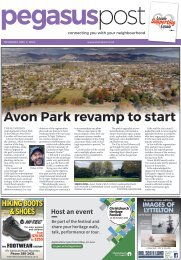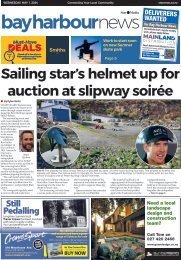Ashburton Courier: January 16, 2020
Create successful ePaper yourself
Turn your PDF publications into a flip-book with our unique Google optimized e-Paper software.
Page 22, <strong>Ashburton</strong>'s The <strong>Courier</strong>, Thursday <strong>16</strong> <strong>January</strong> <strong>2020</strong><br />
Local news at www.starnews.co.nz<br />
Reducing nitrates for industry good<br />
Mayfield dairy farmers Grant and Jan<br />
Early have been involved in the<br />
DairyNZled programme, Forages for<br />
Reduced Nitrate Leaching (FRNL),<br />
which has won an industry award.<br />
The collaborative sixyear programme<br />
focuses on reducing nitrate<br />
leaching onfarm.<br />
It has won aSignificant Achievement<br />
Award through the Canterbury Section<br />
of the New Zealand Institute of<br />
Agricultural and Horticultural Science.<br />
The Early’s were among the more<br />
than 100 people and ten commercial<br />
farms who joined the project to learn<br />
more for themselves and as away to<br />
help the industry.<br />
“Nutrient management is going to<br />
affect everyone. The sooner we have<br />
some tested solutions on how we can<br />
mitigate nitrate leaching, while still<br />
farming profitably, the better it will be<br />
for the industry as awhole,” they said.<br />
At the start of theproject theirfarm,<br />
which sits on Ruapuna soils and has an<br />
annual rainfall of 800mm, was 375 ha,<br />
90 percent irrigated, at astocking rate<br />
of 3.9.<br />
They had a550 ha dryland support<br />
block providing winter grazing (Kale)<br />
and grain for the dairy.<br />
Since being involved in the FRNL<br />
project the couple have made afew<br />
changes to their operation including<br />
plantain in their regrassing regime,<br />
decreasing their stocking rate to 3.7<br />
cows per hectare, introducing fodder<br />
beet on to the milking platform<br />
followed by an oat catch crop and<br />
reduced the support block to 250ha of<br />
irrigated land, using a rotation of<br />
fodder beetbarleyshort rotation<br />
ryegrassfodder beet.<br />
This has resulted in adecrease inN<br />
surplus ofsix percent and estimated N<br />
leaching of 13 percent.<br />
“We now understand the surpluses<br />
that come from nitrogen fertiliser and<br />
nitrogen in supplements, and how we<br />
can change those to make a difference,”<br />
Mr Early said.<br />
DairyNZ senior scientist Dr Ina<br />
Pinxterhuis said those people and<br />
business were involved in the science,<br />
development and farm application of<br />
the FRNL programme identifying pasture<br />
and crop options farmers can use<br />
to reduce nitrate leaching.<br />
“We’re all extremely pleased to<br />
receive this award, and we are even<br />
more delighted to see that many<br />
Grant and Jan Early<br />
farmers have been following the programme<br />
and have already adopted<br />
some of the lower nitrogen pastures,<br />
crops and practices into their farm<br />
systems to improve their environmental<br />
management.”<br />
The programme drew onacrossorganisation<br />
team from DairyNZ, the<br />
Foundation for Arable Research, Lincoln<br />
University, AgResearch,Plant and<br />
Food Research,and Manaaki Whenua<br />
Landcare Research. Eight PhD and<br />
postdoctoral students have been part<br />
of the programme along with several<br />
Honours and Masters students.<br />
“We started in 2013 when farmers<br />
and the community were looking for<br />
better tools and farming practices that<br />
could help reduce nitrates in their<br />
systems and ultimately reduce any<br />
impacts on freshwater and groundwater,”<br />
Dr Pinxterhuis said.<br />
As part of the programme farmers<br />
trialled arange of options to reduce<br />
their nitrogen leaching by 20 percent.<br />
Options included planting lowprotein<br />
feed crops such as fodder beet, and<br />
pasture specieslike plantain and Italian<br />
ryegrass which result in less or diluted<br />
nitrogen excretion by animals and more<br />
nitrogen uptake from the soil.<br />
FRNL scientists are now working<br />
with Overseer so it can model the<br />
practices used as part of the programme.<br />
Fun and games<br />
Spot The Difference<br />
Can you find 10 differences between the pictures?<br />
Mighty Maze<br />
2<br />
SNAKES &<br />
LADDERS<br />
Puzzle One<br />
Can you solve the six-letter words?<br />
Connect the letter pairs in the ladder<br />
on the left with the correct pairs in<br />
the ladder on the right, with middle<br />
letters IL. Wehave solved one to<br />
start you off. GRILLS<br />
Puzzle Two<br />
Use the coloured letters to<br />
make two five-letter words on<br />
the snake’s back.<br />
We have given the first<br />
letter of the red word<br />
and the green word.<br />
BU<br />
CH<br />
GR<br />
NA<br />
SA<br />
SM<br />
C<br />
IL<br />
L<br />
OR<br />
DS<br />
ED<br />
ES<br />
LS<br />
LY<br />
Build AWord<br />
How many words of three or more<br />
letters can you make from these<br />
blocks? Youmay use each letter<br />
only once. Plurals are OK, but no<br />
words starting with acapital letter<br />
are allowed. There is at least one<br />
word that uses all five letters.<br />
Good 7 Very Good 9<br />
Excellent 11+<br />
O<br />
G<br />
H<br />
T<br />
U<br />
©The Puzzle Company<br />
MAZE SOLUTION<br />
All puzzles ©<br />
The Puzzle Company<br />
BEGINNER’S CROSSWORD<br />
Across: 1. Pilots, 5. Present,<br />
6. Explain, 9. Sparks.<br />
Down: 1. Pepper, 2.Lie, 3. Toe,<br />
4. Stings, 7. Pip, 8. Air.<br />
BUILD AWORD<br />
got, gut, hog, hot, hug, hut, OUGHT,<br />
out, thou, thug, tog, TOUGH, tug, ugh<br />
SNAKES AND LADDERS<br />
BUILDS, CHILLY, GRILLS, NAILED,<br />
SAILOR, SMILES.<br />
CRUMB, LORDS.<br />
SPOT THE DIFFERENCE<br />
1 2 3<br />
5<br />
6 7 8<br />
9<br />
4<br />
Beginner’s Crossword<br />
Across<br />
1. People who fly aeroplanes (6)<br />
5. Agift (7)<br />
6. Give an explanation (7)<br />
9. Tiny pieces of burning stuff that jump<br />
out of afire (6)<br />
Down<br />
1. Salt and ______ (6)<br />
2. Tell afib(3)<br />
3. This is on your foot (3)<br />
4. Anettle ______ your skin (6)<br />
7. Aseed in an apple (3)<br />
8. We breathe this (3)


















